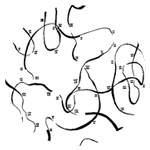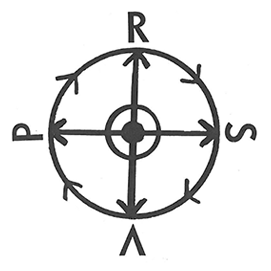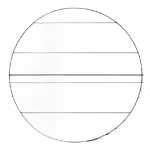- Andersen, Eric. 2012. “In Mezzo a Quattro Tempi.” In Word Events: Perspectives on Verbal Notation, edited by John Lely and James Saunders, 79–82. London: Continuum.
- Anderson, Michael L. 2003. “Embodied Cognition: A Field Guide.” Artificial Intelligence 149 (1): 91–130.
- Anderson, Virginia. 2006. “‘Well, It’s a Vertebrate…’: Performer Choice in Cardew’s Treatise.” Journal of Musicological Research 25 (3–4): 291–317.
- Arms, Jay. 2012. “The Music of Malcolm Goldstein.” M.A. Thesis, University of California, Santa Cruz.
- Armstrong, Newton. 2006. An Enactive Approach to Digital Musical Instrument Design. Saarbrücken: VDM Verlag Dr. Mueller e.K.
- Ashwal, Gary, David Feldman, Kim Eugene Mikyung, Chung Soojin, Evan Malsbury, Sheetal Prajapati, and Samsurin Welch. 2001. “Treatise – Cornelius Cardew – An Animated Analysis.” http://www.blockmuseum.northwestern.edu/picturesofmusic/pages/anim.html.
- Auslander, Philip. 1999. “Fluxus Art-Amusement: The Music of the Future?” Art Papers 23: 30–35. http://uahost.uantwerpen.be/theso/perf/auslanderfluxus.pdf.
- Bailey, Derek. 1993. Improvisation: Its Nature and Practice in Music. Boston: Da Capo Press.
- Barber, Karin. 2007. “Improvisation and the Art of Making Things Stick.” In Creativity and Cultural Improvisation, edited by Elizabeth Hallam and Tim Ingold, 25–41. Oxford, New York: Berg.
- Barrett, Richard. 1999. Transmission. Suffolk: United Music Publishers.
- ———. 2002a. Blattwerk. Suffolk: United Music Publishers.
- ———. 2002b. “Blattwerk: Composition / Improvisation / Collaboration.” http://richardbarrettmusic.com/BlattwerkEssay.html.
- ———. 2005. fOKT. Unpublished score.
- ———. 2011. “Construction of CONSTRUCTION.” http://richardbarrettmusic.com/CONSTRUCTIONessay.pdf.
- ———. 2014. “Notation as Liberation.” TEMPO 68 (268): 61–72. doi:10.1017/S004029821300168X.
- Barrett, Richard, and Paul Obermayer. 2000. “Response to Questions from Nic Collins for Noisy.org.” http://furtlogic.com/node/7.
-
———. 2009. “fORCH.” http://furtlogic.com/nodeorder/term/14.
- Bartlett, Andrew W. 1995. “Cecil Taylor, Identity Energy, and the Avant-Garde African American Body.” Perspectives of New Music 33 (1/2): 274–93.
- Beins, Burkhard. 2011. “Scheme and Event.” In Echtzeitmusik Berlin: Selbstbestimmung Einer Szene | Self-Defining a Scene, edited by Burkhard Beins, Christian Kesten, Gisela Nauk, and Andrea Neumann, 166–181. Hofheim: Wolke Verlag.
- Beins, Burkhard, Christian Kesten, Andrea Neumann, and Gisela Nauk, eds. 2011. Echtzeitmusik Berlin: Selbstbestimmung Einer Szene | Self-Defining a Scene. Hofheim: Wolke Verlag.
- Benson, Bruce Ellis. 2003. The Improvisation of Musical Dialogue: A Phenomenology of Music. Cambridge: Cambridge University Press.
- Boretz, Benjamin. 1981. “If I Am a Musical Thinker.” Perspectives of New Music 20 (1/2): 465–517. doi:10.2307/942424.
- Borgo, David. n.d. “Entangled: The Complex Dynamics of Improvisation.” https://www.academia.edu/22893440/Entangled_The_Complex_Dynamics_of_Improvisation.
- ———. 2007. “Musicking on the Shores of Multiplicity and Complexity.” Parallax 13 (4): 92–107.
- ———. 2014. “The Ghost in the Music: Improvisers, Technology, and the Extended Mind.” https://www.academia.edu/1337731/The_Ghost_in_the_Music_Improvisers_Technology_and_the_Extended_Mind.
- Born, Georgina. 2010. “For a Relational Musicology: Music and Interdisciplinarity, Beyond the Practice Turn: The 2007 Dent Medal Address.” Journal of the Royal Musical Association 135 (2): 205–243.
- ———. 2017. “After Relational Aesthetics: Improvised Musics, the Social, and (Re)theorising the Aesthetic.” In Improvisation and Social Aesthetics, edited by Georgina Born, Eric Lewis, and Will Straw. Durham, NC: Duke University Press.
- Boulez, Pierre. 1990. Orientations: Collected Writings. Edited by Jean-Jacques Nattiez. Translated by Martin Cooper. Cambridge, MA: Harvard University Press.
- Brackett, John. 2010. “Some Notes on John Zorn’s Cobra.” American Music 28 (1): 44–75.
- Braxton, Anthony. 1985. Tri-Axium Writings. Middletown, CT: Synthesis Music.
- ———. 1988. Composition Notes. Middletown, CT: Synthesis Music.
- Brecht, George. 1963. Water Yam. New York: Fluxus.
- Brown, Earle. 1986. “The Notation and Performance of New Music.” The Musical Quarterly 72 (2): 180–201.
- Cage, John. 1975. Child of Tree. Edition Peters Group, Frankfurt/Main, Leipzig, London, New York.
- Cardew, Cornelius. 1961 (2006). “Notation – Interpretation, Etc.” In Cornelius Cardew: A Reader, edited by Edwin Prévost, 5–22. Essex: Copula.
- ———. 1970. Treatise. London: Hinrichsen Edition, Peters Edition Limited.
- ———. 1971 (2006). “Treatise Handbook.” In Cornelius Cardew: A Reader, edited by Eddie Prévost, 95–134. Essex: Copula.
- ———. 1974 (2006). “Stockhausen Serves Imperialism.” In Cornelius Cardew: A Reader, edited by Eddie Prévost, 149–227. Essex: Copula.
- Chiel, Hillel J., and Randall D. Beer. 1997. “The Brain Has a Body: Adaptive Behavior Emerges from Interactions of Nervous System, Body and Environment.” Trends in Neurosciences 20 (12): 553–557. doi:10.1016/S0166-2236(97)01149-1.
- Clancey, William J. 1993. “Situated Action: A Neuropsychological Interpretation Response to Vera and Simon.” Cognitive Science 17 (1): 87–116.
- Clark, Andy, and David Chalmers. 1998. “The Extended Mind.” Analysis 58 (1): 7–19.
- Cobussen, Marcel. 2016. The Field of Musical Improvisation. Leiden: Leiden University Press.
- Cobussen, Marcel, Henrik Frisk, and Bart Weijland. 2010. “The Field of Musical Improvisation.” Konturen 2 (1): 168–85. doi:10.5399/uo/konturen.2.1.1356.
- Collins, Nicolas. 2011. “LMJ 21: Beyond Notation: Communicating Music.” Leonardo Music Journal 21 (1): 5–6.
- Conquergood, Dwight. 1989. “Poetics, Play, Process, and Power: The Performative Turn in Anthropology.” Text and Performance Quarterly 9 (1): 82–88.
- Cook, Nicholas. 2012. “Anatomy of the Encounter: Intercultural Analysis as Relational Musicology.” In Critical Musicological Reflections: Essays in Honour of Derek B. Scott, edited by Stan Hawkins, 193–208. Farnham: Ashgate.
- Corbett, John. 1994. Extended Play: Sounding off from John Cage to Dr. Funkenstein. Durham, NC: Duke University Press.
- Crowe, Cameron. 1977. “Steely Dan Springs Back: The Second Coming.” Rolling Stone, December 29. http://www.theuncool.com/journalism/rs255-steely-dan.
- Dahlhaus, Carl. 1979. “Was Heisst Improvisation?” In Improvisation Und Neue Musik, edited by Reinhold Brinkmann, 8–23. Mainz: Schott.
- de Assis, Paulo. 2013a. “Epistemic Complexity and Experimental Systems in Music Performance 2013.” In Experimental Systems: Future Knowledge in Artistic Research, edited by Michael Schwab, 151–65. Leuven: Leuven University Press. https://issuu.com/me21collective/docs/assis_-_epistemic_complexity_and_ex.
- ———. 2013b. “Prelude.” In Sound & Score: Essays on Sound, Score, and Notation, edited by Paulo de Assis, William Brooks, and Kathleen Coessens, 5–9. Leuven: Leuven University Press.
- Dehlin, Erlend. 2008. “The Flesh and Blood of Improvisation: A Study of Everyday Organizing.” PhD diss., Norwegian University of Science and Technology (Trondheim). http://brage.bibsys.no/xmlui/handle/11250/148918.
- Denley, Jim. 1991. “Improvisation: The Entanglement of Awareness and Physicality.” Sounds Australian 32: 29.
- Dennis, Brian. 1991. “Cardew’s ‘Treatise’ (Mainly the Visual Aspects).” TEMPO (New Series) 3 (177): 10–16. doi:10.1017/S0040298200013516.
- Department of Medieval Studies, Central European University. 2016. “Materials and Techniques of Manuscript Production.” Medieval Manuscript Manual. Accessed November 20. http://web.ceu.hu/medstud/manual/MMM.
- Edlund, Bengt. 1997. “‘Sonate, Que Te Fais-Je’? Toward a Theory of Interpretation.” Journal of Aesthetic Education 31 (1): 23–40. doi:10.2307/3333469.
- Eno, Brian. 2004. “Generating and Organizing Variety in the Arts.” In Audio Culture: Readings in Modern Music, edited by Christoph Cox and Daniel Warner, 226–234. London: A&C Black.
- Evens, Aden. 2005. Sound Ideas: Music, Machines, and Experience. Minneapolis: University of Minnesota Press.
- Feeney, Shawn. 2002. “Cornelius Cardew’s Treatise: Realization | Shawn Feeney.” 2016. http://www.shawnfeeney.com/projects/treatise.
- Feisst, Sabine M. 1997. Der Begriff “Improvisation” in Der Neuen Musik. Sinzig: Studio.
- ———. 2009. “John Cage and Improvisation: An Unresolved Relationship.” Edited by Gabriel Solis and Bruno Nettl. Musical Improvisation: Art, Education, and Society 2 (5): 38–51.
- Feldman, Morton. 2000. Give My Regards to Eighth Street: Collected Writings of Morton Feldman. Cambridge, MA: Exact change.
- Fischlin, Daniel, and Ajay Heble, eds. 2004. The Other Side of Nowhere: Jazz, Improvisation, and Communities in Dialogue. Middletown, CT: Wesleyan University Press.
- Flusser, Vilém. 2002. Writings. Minneapolis: University of Minnesota Press.
- ———. 2011. Into the Universe of Technical Images. Minneapolis: University of Minnesota Press.
- Fox, Christopher. 1995. “Music as Fiction: A Consideration of the Work of Richard Barrett.” Contemporary Music Review 13 (1): 147–57. doi:10.1080/07494469500640331.
- Friedman, Ken. 2016. “A Game without Rules.” Performance Research 21 (4): 9–19.
- Gallagher, Shaun. 2005. How the Body Shapes the Mind. Cambridge Univ Press.
- Goldstein, Malcolm. 1980. Soundings for Solo Violin. LP. Sheffield, VT.
- ———. 1988. Sounding the Full Circle. Sheffield, VT: Malcolm Goldstein. http://frogpeak.org/unbound/goldstein/goldstein_fullcircle.pdf.
- ———. 2011. On and on and Always Slowly Nowhere. Unpublished score.
- Goodman, Nelson. 1968. Languages of Art: An Approach to a Theory of Symbols. Indianapolis: Hackett Publishing.
- Halberstam, Judith. 1998. Female Masculinity. Durham, NC: Duke University Press.
- Hallam, Elizabeth, and Tim Ingold, eds. 2007. Creativity and Cultural Improvisation. Oxford, New York: Berg.
- Halprin, Lawrence. 1969. The RSVP Cycles: Creative Processes in the Human Environment. New York: George Braziller.
- Held, Barbara, and Pilar Subirà, eds. 2008. Possibility of Action. The Life of the Score. Barcelona: Museu d’Art Contemporani de Barcelona.
- Hendricks, Jon, and Robert Pincus-Witten. 1988. Fluxus Codex. Detroit: Gilbert and Lila Silverman Fluxus Collection.
- Higgins, Hannah. 2002. Fluxus Experience. Berkeley: University of California Press.
- Hogwood, Christopher. 2013. “Urtext, Que Me Veux-Tu?” Early Music 41 (1): 123–27. doi:10.1093/em/cat006.
- Hutchins, Edwin. 1995. Cognition in the Wild. Cambridge, MA: MIT Press.
- Ingold, Tim. 2007. Lines: A Brief History. New York: Routledge.
- Iyer, Vijay. 1998. “Microstructures of Feel, Macrostructures of Sound: Embodied Cognition in West African and African-American Musics.” PhD Dissertation, University of Califronia, Berkeley.
- ———. 2004. “Navigation through Form: Composing for Improvisors.” http://www.americancomposers.org/improvise/iyer_essay.htm.
- Jeanneret, Christine. 2013. “The Score as Representation: Technologies of Music Book Production in Italy (1580s-1650s) and Their Editorial Implications.” In Early Music Editing: Principles, Historiography, Future Directions, edited by Theodor Dumitrescu, Karl Kügle, and Marnix van Berchum, 171–94. Turnhout: Brepol.
- Jencks, Charles, and Nathan Silver. 2013. Adhocism: The Case for Improvisation. Cambridge, MA: MIT Press.
- Kanno, Mieko. 2007. “Prescriptive Notation: Limits and Challenges.” Contemporary Music Review 26 (2): 231–254.
- ———. 2012. “As If the Composer Is Dead.” Mortality 17 (2): 170–81. doi:10.1080/13576275.2012.675197.
- Kaprow, Allan, and Jeff Kelley. 2003. Essays on the Blurring of Art and Life. University of California Press.
- Karkoschka, Erhard. 1979. “Improvisation – Überlegungen Ende Der Siebziger Jahre.” In Improvisation Und Neue Musik, edited by Reinhold Brinkmann. Mainz: Schott.
- Kent, Sr. Mary Corita. 1966. Daisy With All The Petals Yes [Two Heads Are Really Better Than One, Yes, Yes, Yes…]. Los Angeles: Immaculate Heart College.
- Kirsh, David, and Paul Maglio. 1994. “On Distinguishing Epistemic from Pragmatic Action.” Cognitive Science 18 (4): 513–549. doi:10.1016/0364-0213(94)90007-8.
- Kotz, Liz. 2001. “Post-Cagean Aesthetics and the ‘Event’ Score.” October 95: 55–89.
- Lash, Dominic. 2011. “Derek Bailey’s Practice/Practise.” Perspectives of New Music 49 (1): 143–71. doi:10.7757/persnewmusi.49.1.0143.
- Lewis, George E. 1996. “Improvised Music after 1950: Afrological and Eurological Perspectives.” Black Music Research Journal 16 (1): 91–122. doi:10.2307/779379.
- ———. 2012. “In Search of Benjamin Patterson: An Improvised Journey.” Callaloo 35 (4): 979–92. doi:10.1353/cal.2013.0023.
- ———. 2013. “Critical Responses to ‘Theorizing Improvisation (Musically).’” Music Theory Online 19 (2). http://mtosmt.org/issues/mto.13.19.2/mto.13.19.2.lewis.php.
- ———. 2014. “Benjamin Patterson’s Spiritual Exercises.” In Tomorrow Is the Question: New Directions in Experimental Music Studies, edited by Benjamin Piekut, 86–108. Ann Arbor: University of Michigan Press.
- Lewis, George, and Benjamin Piekut, eds. 2014. The Oxford Handbook of Critical Improvisation Studies. New York: Oxford University Press.
- Lock, Graham. 1989. Forces In Motion: The Music And Thoughts Of Anthony Braxton. New York: Da Capo Press.
- ———. 2008. “‘What I Call a Sound’: Anthony Braxton’s Synaesthetic Ideal and Notations for Improvisers.” Critical Studies in Improvisation / Études Critiques En Improvisation 4 (1). doi:10.21083/csieci.v4i1.462.
- Maschat, Mathias, and Christopher Williams. 2016. “Three Performances: A Virtual (Musical) Improvisation.” In Experiencing Liveness in Contemporary Performance, edited by Matthew Reason and Anja Mølle Lindelof, 242–53. London: Routledge.
- McMullen, Tracy M. 2010. “Subject, Object, Improv: John Cage, Pauline Oliveros, and Eastern (Western) Philosophy in Music.” Critical Studies in Improvisation / Études Critiques En Improvisation 6 (2). doi:10.21083/csieci.v6i2.851.
- Meelberg, Vincent. 2014. “Musical Improvisation as the Performance of Embodied Knowledge: Embodied Narrativity in Musical Performance.” In Proceedings of CARPA3: Colloquium on Artistic Research in Performing Arts, edited by Annette Arlander. Helsinki: University of the Arts Helsinki, Theatre Academy. https://www.academia.edu/6854151/Musical_Improvisation_as_the_Performance_of_Embodied_Knowledge_Embodied_Narrativity_in_Musical_Performance.
- Monson, Ingrid. 1996. Saying Something: Jazz Improvisation and Interaction. Chicago: University of Chicago Press.
- Moore, Robin. 1992. “The Decline of Improvisation in Western Art Music: An Interpretation of Change.” International Review of the Aesthetics and Sociology of Music 23 (1): 61–84.
- Moseley, Roger. 2013. “Entextualization and the Improvised Past.” Music Theory Online 19 (2). http://www.mtosmt.org/issues/mto.13.19.2/mto.13.19.2.moseley.php.
- Nettl, Bruno. 1974. “Thoughts on Improvisation: A Comparative Approach.” The Musical Quarterly 60 (1): 1–19.
- Neumann, Andrea. 2011. “Playing Inside Piano.” In Echtzeitmusik Berlin: Selbstbestimmung Einer Szene | Self-Defining a Scene, 203–14. Hofheim: Wolke Verlag.
- Noë, Alva. 2004. Action in Perception. Cambridge, MA: MIT Press.
- Östersjö, Stefan. 2008. “SHUT UP ‘N’ PLAY! Negotiating the Musical Work.” PhD diss., University of Lund. http://lup.lub.lu.se/record/1237422.
- Ostertag, Bob. 1993a. Say No More. Unpublished score.
- ———. 1993b. Tongue-Tied. Unpublished score.
- ———. 1996. Verbatim. Unpublished score.
- ———. 2009. Creative Life: Music, Politics, People, and Machines. Champaign, IL: University of Illinois Press. http://www.press.uillinois.edu/books/catalog/88ywq9rp9780252034510.html .
- ———. 2016. “Bob Ostertag in Conversation with Christopher Williams.” Unpublished interview.
- Oteri, Frank. 2012. “Wadada Leo Smith: Decoding Ankhrasmation.” NewMusicBox, May 1. http://www.newmusicbox.org/articles/wadada-leo-smith-decoding-ankhrasmation.
- Partch, Harry. 1949. Genesis of a Music; with a Foreword by Otto Luening. Madison: University of Wisconsin Press.
- Patterson, Ben. 1999. Black and White File. Wiesbaden: (self-published).
- Peters, Gary. 2009. The Philosophy of Improvisation. Chicago: University of Chicago Press.
- ———. 2014. “The Obligation to Improvise.” https://www.academia.edu/15816123/The_Obligation_to_Improvise_Schoenberg_and_Beckett_2014.
- Prévost, Eddie, ed. 2006. Cornelius Cardew: A Reader. Essex: Copula.
- Prévost, Edwin. 2009. “Free Improvisation in Music and Capitalism: Resisting Authority and the Cults of Scientism and Celebrity.” In The Ashgate Research Companion to Experimental Music, edited by James Saunders, 131–44. Farnham: Ashgate.
- Rebelo, Pedro. 2010. “Notating the Unpredictable.” Contemporary Music Review 29 (1): 17–27.
- Russeth, Andrew. 2016. “Ben Patterson, Cornerstone of Fluxus and Experimental Art, Dies at 82 | ARTnews.” http://www.artnews.com/2016/06/27/ben-patterson-cornerstone-of-fluxus-and-experimental-art-dies-at-82.
- Rutherford-Johnson, Tim, Michael Kennedy, and Joyce Bourne Kennedy. 2012a. “Notation.” Oxford: Oxford University Press. http://www.oxfordreference.com/10.1093/acref/9780199578108.001.0001/acref-9780199578108-e-6533.
- ———. 2012b. “Score.” Oxford: Oxford University Press. http://www.oxfordreference.com/10.1093/acref/9780199578108.001.0001/acref-9780199578108-e-8167.
- Rzewski, Frederic. 1999. “Little Bangs: A Nihilist Theory Improvisation.” Current Musicology 67/68: 377.
- Sancho-Velázquez, Angeles. 2001. “The Legacy of Genius: Improvisation, Romantic Imagination, and the Western Musical Canon.” PhD diss., University of California, Los Angeles.
- Schuiling, Floris. 2015. “Animate Structures: The Compositions and Improvisations of the Instant Composers Pool Orchestra.” PhD diss., Cambridge University.
- ———. 2016. “The Instant Composers Pool: Music Notation and the Mediation of Improvising Agency.” Cadernos de Arte E Antropologia 5 (1): 39–58.
- “Score, N.” 2016. OED Online. Oxford University Press. Accessed August 31. http://www.oed.com/view/Entry/173033.
- Seeger, Charles. 1958. “Prescriptive and Descriptive Music-Writing.” The Musical Quarterly 44 (2): 184–195.
- Sennett, Richard. 2008. The Craftsman. New Haven: Yale University Press.
- Silverstein, Michael, and Greg Urban, eds. 2016. Natural Histories of Discourse. Chicago: University of Chicago Press.
- Smithers, Tim. 1996. “On What Embodiment Might Have to Do with Cognition.” In Proceedings AAAI Fall Symposium, Embodied Cognition and Action, edited by Maja Mataric, 113–118. http://www.aaai.org/Papers/Symposia/Fall/1996/FS-96-02/FS96-02-024.pdf.
- Stegmann, Petra, ed. 2014. Benjamin Patterson – Sneak Review. Potsdam: Down with Art!
- Stegmayer, Benedikt, ed. 2012. Ben Patterson – Event Scores. Berlin: Verlag für Zeitgenössische Kunst und Theorie.
- Stoessel, Jason. 2013. “Scribes at Work, Scribes at Play: Challenges for Editors of the Ars Subtilior.” In Early Music Editing: Principles, Historiography, Future Directions, edited by Theodor Dumitrescu, Karl Kügle, and Marnix van Berchum, 49–75. Turnhout: Brepol.
- Stone, Kurt. 1980. Music Notation in the 20th Century. New York: WW Norton.
- Suchman, Lucy. 2007. Human-Machine Reconfigurations: Plans and Situated Actions. Cambridge: Cambridge University Press.
- Taylor, Cecil. 1966. “Sound Structure of Subculture Becoming Major Breath/Naked Fire Gesture.” In Unit Structures. LP, Blue Note 84237.
- Tilbury, John. 2008. Cornelius Cardew (1936-1981): A Life Unfinished. Essex: Copula.
- Toop, David. 2016. “FLAT TIME/sounding.” In Artistic Practice as Research in Music: Theory, Criticism, Practice, edited by Mine Dogontan-Dack, 237–54. London: Routledge.
- Turnbull, David. 1993. “The Ad Hoc Collective Work of Building Gothic Cathedrals with Templates, String, and Geometry.” Science, Technology & Human Values 18 (3): 315–340.
- Vaes, Luc Paul Frank. 2009. “Extended Piano Techniques : In Theory, History and Performance Practice.” PhD diss., University of Leiden. https://openaccess.leidenuniv.nl/handle/1887/15093.
- Waterman, Alex, Debra Singer, and Matthew Lyons, eds. 2007. Between Thought and Sound: Graphic Notation in Contemporary Music. New York: The Kitchen.
- Watts, Victoria. 2010. “Dancing the Score: Dance Notation and Différence.” Dance Research 28 (10): 7–18.
- Whitehead, Kevin. 1998. New Dutch Swing. New York: Watson-Guptill Publications.
- Williams, Christopher. 2008. Apples Are Basic. Unpublished score.
- Wilson, Peter Niklas. 1999. Hear and Now. Hofheim: Wolke Verlag.
- Wooley, Nate. 2015a. “Anthony Coleman and Survivors Breakfast Explore Treatise.” Sound American 12. http://soundamerican.org/sa_archive/sa12/sa12-the-treatise-performances.html.
- ———. 2015b. “Mostly Other People Do The Killing Are Detained By Treatise.” Sound American 12. http://soundamerican.org/sa_archive/sa12/sa12-the-treatise-performances.html.
- ———. 2015c. “Richard Barrett On Treatise And Improvisation.” Sound American 12. http://soundamerican.org/sa_archive/sa12/sa12-eddie-prevost-and-richard-barrett-on-treatise.html.
- ———. 2015d. “The Treatise Issue.” Sound American 12. http://soundamerican.org/sa_archive/sa12/index.html.
- Xenakis, Iannis. 1973. Evryali. Paris: Salabert.
- Young, La Monte, ed. 1963. An Anthology of Chance Operations… New York: La Monte Young & Jackson MacLow.
References



